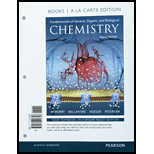
a)
Interpretation: The symbol of the Silver ion to be predicted.
Concept Introduction:
Naming monoatomic Ions: Main group metal cations are named by identifying the metal name, followed by the word ‘ion’.
Naming
Naming Anions: Anions are named by replacing the end of the element name with ‘-ide’, followed by the word ‘ion’.
b)
Interpretation: The symbol of the Iron ion to be predicted.
Concept Introduction:
Naming monoatomic Ions: Main group metal cations are named by identifying the metal name, followed by the word ‘ion’.
Naming Transition metal ion: In general, transition metal exhibits various oxidation state and the naming follows the rule, transition metal is identified by the name, followed by the oxidation number of the particular ion.
Naming Anions: Anions are named by replacing the end of the element name with ‘-ide’, followed by the word ‘ion’.
c)
Interpretation: The symbol of the Copper ion to be predicted.
Concept Introduction:
Naming monoatomic Ions: Main group metal cations are named by identifying the metal name, followed by the word ‘ion’.
Naming Transition metal ion: In general, transition metal exhibits various oxidation state and the naming follows the rule, transition metal is identified by the name, followed by the oxidation number of the particular ion.
Naming Anions: Anions are named by replacing the end of the element name with ‘-ide’, followed by the word ‘ion’.
d)
Interpretation: The symbol of the Tellurium ion to be predicted.
Concept Introduction:
Naming monoatomic Ions: Main group metal cations are named by identifying the metal name, followed by the word ‘ion’.
Naming Transition metal ion: In general, transition metal exhibits various oxidation state and the naming follows the rule, transition metal is identified by the name, followed by the oxidation number of the particular ion.
Naming Anions: Anions are named by replacing the end of the element name with ‘-ide’, followed by the word ‘ion’.
Want to see the full answer?
Check out a sample textbook solution
Chapter 3 Solutions
Fundamentals of General, Organic, and Biological Chemistry, Books a la Carte Edition; Modified Mastering Chemistry with Pearson eText -- ValuePack ... and Biological Chemistry (4th Edition)
- Calculate the molar mass of each of the following compounds:(a) Calcium carbonate, CaCO3 (b) Urea, CO1NH222 (c) Ethane-1,2-diol, C2H6O2arrow_forwardBalance the following equation, and tell how many moles of nickel will reactwith 9.81 mol of hydrochloric acid.arrow_forwardWhat is the empirical formula for a compound that is 26.56% potassium, 35.41% chromium, and 38.03% oxygen?arrow_forward
- Ferrous sulfate is one dietary supplement used to treat iron-deficiency anemia. What are the molecular formula and molecular mass of this compound? howmany milligrams of iron are in 250 mg of ferrous sulfate?arrow_forwardConsider these compounds: A. PbBr, B. MnS C. Ag,CO3 D. AIPO, Complete the following statements by entering the letter(s) corresponding to the correct compound(s). (If more than one compound fits the description, include all the relevant compounds by writing your answer as a string of characters without punctuation, e.g, ABC.) Without doing any calculations it is possible to determine that magnesium fluoride is more soluble than and magnesium fluoride is less soluble than| It is not possible to determine whether magnesium fluoride is more or less soluble than by simply comparing Kgp values.arrow_forwardThe empirical formula of the sugar glucose is C6H12O6. (a) How many moles are there in 270 g of glucose? (b) Calculate the molarity of a solution of 324 g of glucose dissolved in 2.0 l of water.arrow_forward
- Assume that the mixture of substances in drawing (a) undergoes a reaction. Which of the drawings (b)–(d) represent a product mixture consistent with the law of conservation of mass?arrow_forwardWhat is the molarity of a solution that contains 50.0 g of vitamin B1 hydrochloride (molar mass = 337 g/mol) in 160 mL of solution?arrow_forwardWrite a skeletal equation for the following chemical change. Solid lithium reacts with chlorine gas to produce solid lithium chloride.arrow_forward
- An unknown mixture is known to contain only Ba(OH)2 (MW=171.34 g/mole) and NaOH (MW=40.0 g/mole). If the mixture is known to contain 45% by mass NaOH, and 8.0 grams of the mixture is dissolved completely in 50.0 ml of solution, answer the following. c).If 10.0 ml of a 0.2 M solution of Na2SO4 was added to the 50.0 ml solution, what would be the final concentration of Na+ in solution.arrow_forwardHow many grams of CuSO4 would you use to make 1 L of an 8 g/L CuSO4 solution?arrow_forwardLisa and Jisoo wanted to prepare 150 mL of 0.650 M malonate buffer pH 5.00 by mixing NaC4H304 and Na2C3H204. Relevant Reaction: Ка, 3 1.4x10з Kaz = 2.0x10 6 C;H,O4 2 C,H;O4 1. What mass of solid NaC3H3O4 (MM = 138.054 g/mol) and solid Na2C3H2O4 (MM = 148.026 g/mol) will be needed to prepare the buffer? a. mass of solid NaC3H3O4 needed: b. mass of solid NazC3H2O4 needed: garrow_forward
